
Dealing With the Deceased Menu: 1 2 3 4 5 6 Next>>
Dealing With the Deceased in the Golden Age of Piracy, Page 3
Burial Preparation
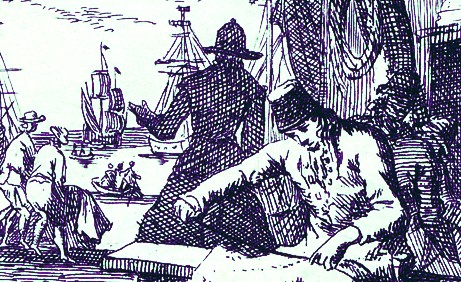
Artist: Jan Luyken -
De Seile Maaker (1694)
There were several steps that may have been taken to prepare a body for burial. The first involved washing and dressing a body. The second included attaching weights to the corpse when the body was to be buried at sea so that it would be sure to sink. The last step discussed here involved enclosing the body; it would be encased in a shroud, often made from canvas or blankets, which would be sewn up with the body inside by the sail-makers. The shrouded body might also be placed in a coffin.
Once the body was readied, David Stewart suggests that, "the period before burial mirrored the social structure on land. The bodies of common sailors were usually taken up to the main deck and placed immediately abaft the mainmast to await burial."1 While such particulars are not mentioned in any of the period accounts, they do make sense.
1 David J. Stewart, The Sea Their Graves, 2011, p. 120
Burial Preparation - Washing and Dressing the Body
The body could be readied by washing it. Historian David Stewart says, "Washing prior to burial is a
gesture of respect, but also has symbolic functions."1 He points to the fact that many societies

Artist: Mattheus von Helmont
Bringing a Bucket of Water
(17th century)
regard corpses as unclean objects, something mentioned in the Old Testament.2
Stewart explains that washing the body would be performed by his "messmates, who were typically the deceased's closest friends aboard ship", drawing a parallel to land procedures. By way of proof, he points to Herman Melville's 1850 book White Jacket: or, The World in a Man-of-War. Melville says of a recently deceased mess-mate that he was "laid on the floor, and washed with a bucket of water which I drew from the ocean"3. Melville's account most likely draws upon his experiences aboard the whaler Acushnet in 1841-1844, more than one hundred years after the golden age of piracy ended.
The washing of the corpse is actually mentioned in one of the accounts given in Captain Johnson's second book, The History of the Pirates. It is not performed shipboard, however, nor is it performed by the sailors. It is found in the account of the fictional pirate Captain Misson when his ships returned to Johanna Island (Anjouan of the Comoros Islands between Madagascar and Africa) where they had set up relationships with the natives following a battle. "Their Johanna wives expressed a concern they did not think them capable of; nay, a wife of one of the wounded men who died, stood some time looking upon the corpse as motionless as a statue, then embracing it, without shedding a tear, desired she might take it ashore to wash and bury it"4. However, this is stated to be a local -style burial. In addition, the fact that the account is recognized as fictional cannot be dismissed.
Washing of the corpse is not specifically mentioned in any of the period accounts, it cannot be said with certainty that it was part of the preparation of the body on a ship during the period under scrutiny. However, most of the accounts are fairly minimal in detail of this part of burial and it could easily have been done. If the body were washed, it would then be clothed, presumably in the best suit of clothes that the sailor had among his effects.
1 David J. Stewart, The Sea Their Graves, 2011, p. 116; 2 "He that toucheth the dead body of any man shall be unclean seven days." Numbers 19:11, King James Bible; 3 Herman Melville, White Jacket: Or, The World in a Man-of-War, p. 320; 4 Captain Charles Johnson, The History of the Pirates, p. 40
Burial Preparation - Attaching Weights to Sink the Corpse
When a body was to be buried at sea, weights

Artist: Paul Delaroche & Mission
Floating Corpse, Based on Le Juene Martyre (1855)
were included with the corpse to make sure that it sank. This could be important for the well-being of the men on the ship as a few period examples show.
The crew of the ship Johann Dietz was serving on in the late 17th century had performed the burial ceremony for a deceased carpenter, "whereupon he floated in the wake of the ship. Whether the bears ate him, or the seals, I know not; but his ghost was repeatedly seen on board the vessel. This is a matter that I shall not discuss."1 While this is one of the rare mentions of the ghost of a man buried at sea haunting a ship from this period, the idea was likely exacerbated by the fact that the body had not been weighted sufficiently enough to immediately sink out of sight.
Silas Told took a more spiritual view of insufficiently weighted corpses which refused to sink after being put over the side of the ship. In his account, he notes that a woman whom Captain Timothy Tailor had brought on the voyage who had "died in a shocking manner, was sewed up in a hammock, and thrown overboard with a bag of ballast at her feet, in order to sink her; but in the course of a week afterwards the corpse of the woman was observed to float upon the water: I believe God had suffered this uncommon circumstance to happen in order to open the eyes of our wicked captain; but he had no dread or remorse in him."2
Several accounts mention this procedure, suggesting

Photo: Wiki User Chris 73
Cannon Projectiles Recovered from the Vasa Wreck of 1628 Which Could Be Used as Weights
a couple of ways to weight the corpse. Edward Barlow said that when a sailor was dead, the crew would "tie to his feet two or three cannon bullets, and so to heave him overboard"3. Silas Told mentioned using ballast in both the burial of the European woman discussed previously as well as that of Captain Roach, where "a bag of ballast fastened to his feet"4.
David Stewart suggests that weights were tied to the feet of corpses for a reason. "Weighted at the feet, the corpse would sink feet first, with the head facing outward and away from the vessel. As in the funeral procession on land [where the body was moved in such a manner that it was always faced away from its former house], the dead would not be able to 'see' his former abode, making it less likely that his ghost could return."5
However, there are some accounts that do not limit the attachment of weights to the feet. The crew on Thomas Gage's ship buried Friar John de la Curva at sea having "weighty stones hung to his feet, two more to his shoulders, and one to his brest."6 In his dictionary for seamen, John Smith recommended that the sailors bury men at sea "with each a weight or Bullet at their Heads and Feet to make them sink"7. Such comments suggest that the primary, if not the only, purpose in attaching weights to the corpse was to send it to the bottom.
1 Johann Dietz, Master Johann Dietz, Surgeon in the Army of the Great Elector and Barber to the Royal Court, p. 148; 2 Silas Told, An Account of the Life, and Dealings of God with Silas Told &c., 1786, p. 23; 3 Edward Barlow, Barlow's Journal of his Life at Sea in King's Ships, East and West Indiamen & Other Merchantman From 1659 to 1703, p. 214; 4 Told, p. 30; 5 David J. Stewart, The Sea Their Graves, 2011, p. 118; 6 Thomas Gage, A New Survey of the West Indies, 1677, p. 44; 7 John Smith, Seaman's Grammar and Dictionary, 1691, p. 61
Burial Preparation - Wrapping the Body in a Shroud
Many accounts of the funeral procedures performed for men who died at sea from this period feature the encasement of the deceased in a shroud. Historian David Stewart notes, "Shrouds had been used on land for the burial of most people until the late seventeenth century, so their use aboard ship was simply the continuation of another land-based tradition."1
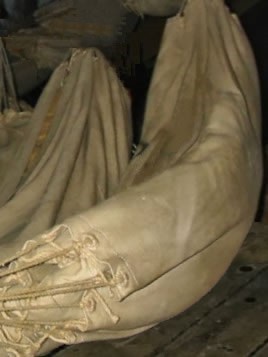
A variety of materials could be used, probably dependent largely on what was available to them and would be least missed. In a mournful muse on the fate of a sailor, Edward Barlow says "when he is dead to sew him up in an old blanket or piece of old canvas"2. Francis Rogers likewise noted that when their cook died in 1702, they sewed "him up in a blanket"3.
The most usually recognized shroud for a dead sailor was his own hammock, particularly in accounts beginning in the mid and late eighteenth century. Historian Stewart points out that hammocks had been used as beds by sailors since the seventeenth century, particularly on naval vessels, "which had large crews and limited sleeping space."4 He posits two reasons why a hammock may have been preferred as shroud.
First, many sailors were superstitious of wearing a dead man's clothes, and it would be natural for this taboo to be applied to a deceased person's hammock as well. Also, the hammock would have been seen as an appropriate burial shroud because of its association with sleeping. Sleep was a popular metaphor for death, especially in the nineteenth century.5
While these ideas have the appeal of being fantastic and grotesque, neither is supported by any of the golden age of piracy era accounts in our sample. This lack of support in period documents is troublesome. As we shall see later, a dead man's effects were sometimes auctioned off after burial,
Photo: Wiki User Boatbuilder
Hammock Display for the Kronan at Kalmar Läns Museum
suggesting that the superstition about clothing may not have been true. Stewart also admits that the 'sleep to death' metaphor was associated with later period sailors,
limiting the effectiveness of this interpretation with regard to the golden age of piracy. It seems more likely that a hammock was simply the ideal size and type of material for a shroud, particularly when burying a man at sea. In addition, whether someone believed in spirits or not, It could be unsettling to sleep in a hammock where someone died.
Few of the actual period accounts mention the use of a hammock as a shroud. The exception is Silas Told's account of his travels around 1726 - 1730. If the other accounts fail to mention hammocks as shrouds, Told consistently says as much. When a man died from drinking too much water around 1726, Told explains simply, "we sewed him up in a hammock"6. When the female consort of Captain Tucker died around 1727, she "was sewed up in a hammock"7. And when Captain Roach expired on a voyage a year or two later, "He was sewed up in his hammock"8.

Artist: Charles Mosely
The Hammock-wrapped Ghosts of Admiral Hosier (1740)
In the decades following the golden age of piracy, a wide variety of sources indicate the use of the deceased man's hammock to encase him after death.9 Perhaps the most vivid and extraordinary is an excerpt from the Ballad of Admiral Hosier’s Ghost from 1740:
Then each heart with fear confounding,
A sad troop of ghosts appear’d.
All in dreary hammocks shrouded,
Which for winding-sheets they wore10
However, since most period accounts do not specify the use of a hammock to wrap the body of a deceased sailor, an argument could be made that hammocks were not the standard shroud of sailors until near the end of the golden age of piracy.
1 David J. Stewart, The Sea Their Graves, 2011, p. 117; 2 Edward Barlow, Barlow’s Journal of his Life at Sea in King’s Ships, East and West Indiamen & Other Merchantman From 1659 to 1703, p. 214; 3 Francis Rogers, "The Journal of Francis Rogers", Three Sea Journals of Stuart Times, Bruce S. Ingram, editor, 1936, p. 163; 4,5 Stewart, p. 117; 6 Silas Told, An Account of the Life, and Dealings of God with Silas Told &c., 1786, p. 12; 7 Told, p. 23; 8 Told, p. 30; 9 See for example: Common Sense, March 28. 1741 (No. 216) found in The Gentleman's and London Magazine: Or Monthly Chronologer, 1741-1794, p. 191; Edmund Burke, The Annual Register, Or, A View of the History, Politics, and Literature for the Year 1761, p. 104; and Carl Peter Thunberg, Travels in Europe, Africa and Asia: Performed Between the Years 1770 and 1779, 1793, p. 188, among many others; 10 Richard Glover, Ballad of Admiral Hosier’s Ghost, 1740, retrieved from Bartleby.com on 10/7/15
Burial Preparation - The Last Stitch Through the Nose?
The body of a sailor was often sewn into his shroud by a ship's sail makers, who had the equipment and expertise to do so. A recurring feature of this practice when it is mentioned in modern times is having the last suture the sail makers took passed through the nose of the decedent. The idea was that if a man were not actually dead, he would not stand for this painful Parthian stitch.
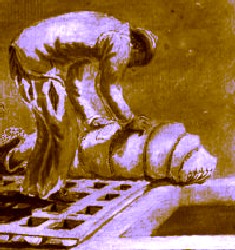
Artist: Gabriel Bray
From Ticketing the Hammock (1774)
While this appears to have been a standard practice in the 19th century, there is no evidence from the 17th or 18th century suggesting its use. Such a stitch is mentioned in an 1831 account.1 As a sail maker was sewing the ship's pilot into his hammock, he explained to the author, "I have heard it said that it was customary to run the needle in the last stitch through the nose of the corpse; some may do it, but I certainly never remarked it myself."2 It is interesting that the sail maker refers to this as 'customary', yet this is the earliest printed reference to it that of which I have learned.
It must not have been all that customary in the late 18th century. Dr. Charles Peter Thunberg related an account which highlights this in the 1770s. The crew of the ship he was aboard felt the surgeon in charge of checking to make sure the dead were truly dead was both ignorant and negligent.
Another morning five men were reported dead; all of whom had been sewed up in their hammocks, and two of them had already been thrown overboard, when the third, the instant he was put on the plank, called out, 'Master boatswain, I am still alive;' to which the boatswain, with unseasonable jocularity, replied, -'You alive, indeed! What, do you pretend to know better than the surgeon!'3
Had the fabled 'last stitch' been given, the surgeon would almost certainly have been aware that the man was alive before he reached the plank. Since the regular practice of using hammocks as shrouds may not have been a regular practice until around 1725, it should not be surprising that the stitch through the nose wasn't practiced until some time afterwards.
1 Thanks to Alan Gutchess for pointing this reference out to me during a discussion on the Authentic Pirate Living History Facebook page; 2 Frederick Charrier, “The Life of a Sailor. – No. IV.”, Metropolitan Journal of Literature, Vol. I, May to August, August 1831, p. 393; 3 Charles Peter Thunberg, M.D., “Travels in Europe, Africa, and Asia, performed Between the Years 1770 and 1779”, Historical Account of the Most Celebrated Voyage, Travels, and Discoveries, William Mavor, Ed, p. 167-8
Burial Preparation - Coffins
Perhaps the most famous burial at sea in a coffin was that of Sir Francis Drake in 1595. One apparent eye-witness account explains that after Drake's "Corps being laid in a Cophin of Lead, he was let downe into the Sea"1. Drake's rank and importance may have been the reason such an elaborate box was constructed for his burial.
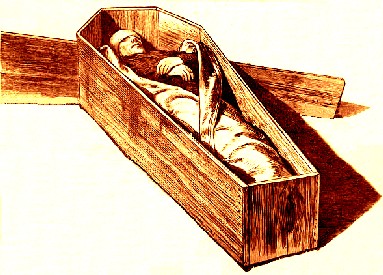
Body in Coffin, From Leslie's Monthly Magazine, April 14, 1877
In order to have a coffin for a shipboard burial ceremony, it would have been constructed by the ship's personnel, requiring the use of ship's resources. If the burial was to be performed at sea, as Drake's was, this work would only have been sent to the bottom of the ocean shortly after it was completed. In most of the cases from this period where a coffin is mentioned as part of the ceremony, the decedent held a rank or station in life that suggested more elaborate preparations for their burial were appropriate. In a 1672 Journal entry, Edward Barlow notes that one of the benefits of the burial of a sailor to his family was that they would not "be at the charges of making his grave and his coffin" explaining that the sailor would only have to be sewn into "an old blanket or piece of old canvas."2
Barlow only mentions the use of a coffin for burial once in his four decades of sea service. That was for the burial of a wealthy merchant who died during travel. He "had a coffin made for him and was thrown overboard"3.
Merchant slaver captain Thomas Phillips mentions three burials in his account of a 1693-4 voyage to Africa. Only one of them specifically mentions a coffin. Phillips explains, "when the coffin being ready, the deceas’d was nail’d up therein; and our pinnace being hoisted out, he was lower’d into her, and myself, my doćtor and purser went in her to bury him" on land.4 While the other two do not say if a coffin was employed, they do not mention any other method of sealing up the corpse.
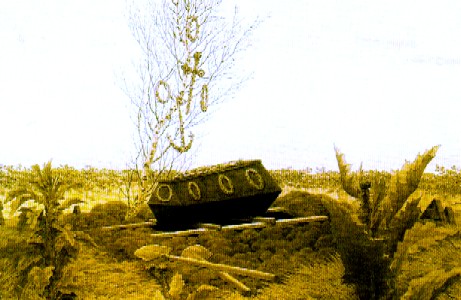
Artist: Caspar David Friedrich - "At the Edge of the Ditch", Coffin and Grave (1836)
Naval Chaplain Henry Teonge mentions using coffins for the burial of men of rank who died on his ships several times. The first example was a coffin for boatswain Richard Capps who "was nobly buryed, and like a souldyer. He had a neate coffin [made for him]"5. A second example of a coffin involved a Lieutenant. Teonge's diary entry for December 26, 1678 explains "This aftemoone wee put our leiuetenant into a coffin, but know not when wee shall bury him."6 It is interesting that a coffin was built before they knew if the man would be buried on land or not. Since the ship was at anchor, it was likely believed he would be, adding to the appropriateness of this extra touch.
The final example from Teonge is probably one of the most interesting in that the man buried does not appear to have been a person of any special rank and the ship was travelling so he was going to be buried at sea. Teonge does not give much detail, simply stating, "I buryed Mr. Richard Cooling in a coffin."7 It is even more curious because Teonge talks about burying four other men at sea in the two weeks previous, never saying anything about them being put into coffins. The only other mention of Cooling in Teonge's diary is when he nearly got into a fight with another sailor.8 So it is possible that coffins may have been used to bury regular sailors at sea, although this is an isolated example.
1 A Full Relation of Another Voyage into the West Indies made by Sir Francis Drake, Printed at London for Nicholas Bourne, 1652, p. 58; 2,3 Edward Barlow, Barlow’s Journal of his Life at Sea in King’s Ships, East and West Indiamen & Other Merchantman From 1659 to 1703, Volume I, 1659-1677, 1934, p. 214; 4 Thomas Phillips, 'A Journal of a Voyage Made in the Hannibal', A Collection of Voyages and Travels, Vol. VI, Awnsham Churchill. ed., p.196; 5 Henry Teonge, The Diary of Henry Teonge, Chaplain on Board H.M.’s Ships Assistance, Bristol, and Royal Oak, 1675-1679, 1825, p. 100; 7 Teonge, p. 270; 7 Teonge, p. 302; 8 Teonge, p. 282

